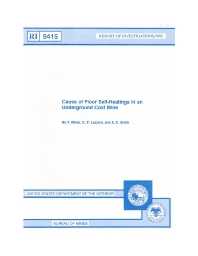Mining Publication: Cause of Floor Self-Heatings in an Underground Coal Mine
Original creation date: January 1992
This report presents a U.S. Bureau of Mines study to identify the causes of self-heating events beneath the floor of a deep underground mine. Mine samples from both heated and unheated areas were examined by various techniques, including visual, microscopic, thermal, chemical, and instrumental tests. The combined results led to the conclusion that pyrite (FeS2) oxidation was the prime cause of the heatings. However, adiabatic oven tests of selected samples did not indicate the effect of the pyrite on the self-heating process, probably because of the experimental conditions. A fast, simple procedure to assess concentration of pyrite in the mine samples was developed, utilizing the reactivity of the sample with an aqueous solution of hydrogen peroxide (H2O2).
Authors: Y Miron, CP Lazzara, AC Smith
Report of Investigations - January 1992
NIOSHTIC2 Number: 10011376
U.S. Department of the Interior, Bureau of Mines, Report of Investigations 9415, 1992 Jan:1-24
See Also
- Progress Toward Improved Engineering of Seals and Sealed Areas of Coal Mines
- Refuge Alternatives in Underground Coal Mines
- Rock Dusting Considerations in Underground Coal Mines
- Safe and Economical Inerting of Sealed Mine Areas
- SPONCOM - A Computer Program for the Prediction of the Spontaneous Combustion Potential of an Underground Coal Mine
- Technology News 535 - NIOSH Releases New Educational Video: Escape from Farmington No. 9: An Oral History
- Technology News 545 - NIOSH Updates Spontaneous Combustion Assessment Software
- Ultra-Low Frequency Through-the-Earth Communication Technology
- Wireless Mesh Mine Communication System
- Work Sampling Applied to a Human Factors Analysis of Mine Worker Positioning
- Content source: National Institute for Occupational Safety and Health, Mining Program


 ShareCompartir
ShareCompartir
